Being a good neighbor can have a powerful effect on the attitudes and behaviors of others in your community, according to a new study.
While most research examining the relationship between people and place has looked at individual characteristics reflecting lifecycle stages, such as marital status, family size, and children’s ages, the new study instead looked at potential mechanisms that link neighborhood disadvantage with neighborly attitudes and behaviors.
Under the right conditions, community matters in the 21st century—and it can still positively affect lives, says Gregory Sharp, an assistant professor in the sociology department at the University at Buffalo.
“We know that living in disadvantaged neighborhoods is associated with dissatisfaction, but the effect is amplified by fear, isolation, and a lack of social support,” says Sharp, an expert in urban and community sociology. “Having frequent conversations with neighbors, doing favors for one another, and watching each other’s home makes a difference. This is neighboring.”
Neighbors and communities
Neighborly interactions have a cumulative effect, Sharp says. The new results, which appear in City & Community, suggest that neighboring encourages residents to become more active in their communities, regardless of the level of disadvantage.
“Policymakers need to hear this,” says Sharp. “Neighborhoods and communities matter. They have consequences for people’s lives and their life chances—and their attitudes often determine whether they’ll be invested in the places they live.”
“Many neighborhoods are composed of residents who regularly connect with one another, foster meaningful bonds, and are ultimately satisfied with their surroundings.”
Sharp used data from the Los Angeles Family and Neighborhood Survey to examine how neighborhood disadvantage affects residents’ satisfaction and interactions.
The survey is a longitudinal study that covers two waves of attitudes from 2000-02 and 2006-08 in 65 neighborhoods and more than 3,000 households.
“What better city to look at for this kind of work?” asks Sharp. “Los Angeles is a huge multiracial and multiethnic metropolis. And the survey digs into not only the attitudes and perceptions of residents about their neighborhood, but also their actual behaviors in the neighborhood.”
21st century neighborhoods
To realize the value of neighboring demands considering how perceptions and experiences with neighborhood danger factors into attitudes. Just as neighboring can snowball into neighborhood investment, living in the most disadvantaged neighborhoods can intensify fear and work against the advantages that consistent interactions generate, Sharp says.
“People exposed to pernicious neighborhood conditions that evoke fear and mistrust suffer an amplification effect that can result in social isolation and loneliness,” he says.
But even demonstrating the importance of including neighborhood characteristics along with perceptions and experiences raises questions about the nature of neighborhoods in the 21st century.
Urban sociology grounds itself in what’s known as the Chicago School, a mindset emerging from the early 20th century that asked how the transition from agrarian to industrial centers would impact the vitality of community life.
Something similar is happening today with emerging digital technologies. But these new technologies are not creating an environment that’s eclipsing today’s communities, Sharp says.
“Many neighborhoods are composed of residents who regularly connect with one another, foster meaningful bonds, and are ultimately satisfied with their surroundings,” says Sharp. “Fully understanding how this occurs should help scholars and policy makers anticipate how communities will change in the future.”
Source: University at Buffalo



